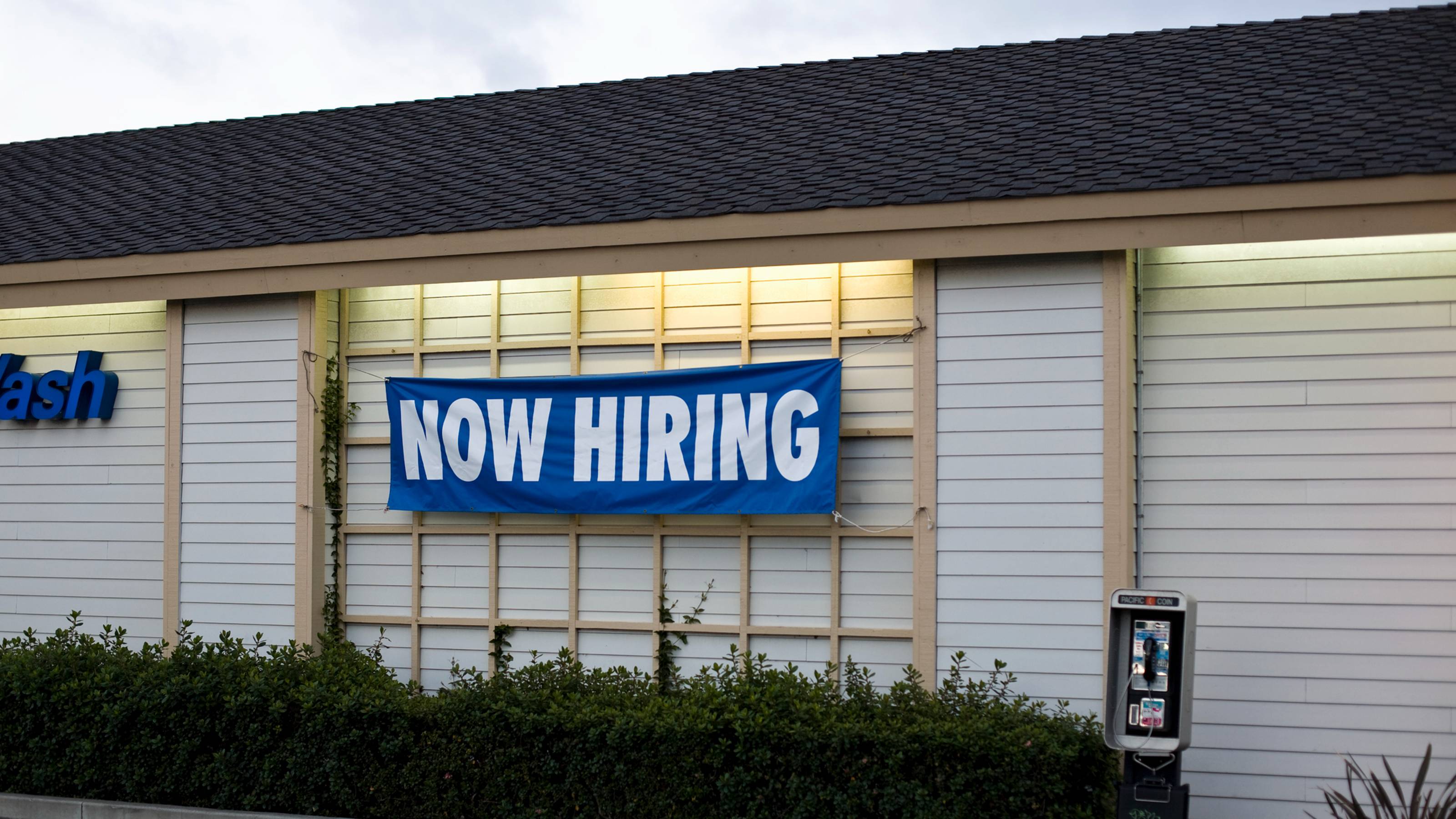
Jobs growth exceeded estimates by more than half in March, and that creates a problem. Bulls say moderating wage growth and an increase in the participation rate keep the Federal Reserve on track to reduce interest rates as soon as June, but bears contend the central bank is running out of time to enact three cuts before the end of the year.
U.S. nonfarm payrolls increased a whopping 303,000 in March, the Bureau of Labor Statistics said Friday, easily topping economists' estimate for the creation of 200,000 jobs. The unemployment rate, which is derived from a separate survey, ticked down to 3.8% from 3.9%, a two-year high. Unemployment remains at half-century lows.
In more dovish news, hourly wages increased a comparatively modest 0.3%, which was in line with forecasts. On an annual basis, hourly wages rose 4.1%, or the slowest rate of increase in almost three years.
Fed Chief Jerome Powell and the Federal Open Market Committee (FOMC) have signaled a total of three rate cuts this year, but the robust labor market – and some sticky inflation data – are making the central bank's job more complicated.
At the same time, market participants are eagerly awaiting the Fed's first quarter-point cut, which will bring rates down from a 23-year high. As of April 5, futures traders assigned a 53% probability to the Fed enacting its first cut in June, down from 59% a day ago, according to CME Group's FedWatch Tool.
With the March jobs report now a matter of record, we turned to economists, strategists and other experts for their thoughts on what the data means for markets, macroeconomics and monetary policy going forward. Please see a selection of their commentary, sometimes edited for brevity or clarity, below.
March jobs report: The experts weigh in

"Another blowout payroll report suggests the economy is running strong and far from recession, with the economy averaging 276,000 job growth per month over the last quarter and unemployment rate at 3.8%. On balance, this would push out any rate cuts by the Fed, but easing wage growth means we're not in the middle of a labor-market induced inflation surge. Today's payroll report confirms the economy is strong, and ultimately that's good for profit growth and the stock market. Easing wage growth and strong productivity should also ease fears that core inflation is going to spike higher." – Sonu Varghese, global macro strategist at Carson Group
"March non-farm payrolls mark another strong data point that puts paid to the FOMC's disingenuous discussion about 'two-sided risks.' The U.S. economy is strong, and inflation (we are learning) does not succumb to the magic of supply. We will soon find out if the Fed's 'data-dependence' was idle blather or serious policy. Our base case is still for two cuts in the second half of this year, but the 'higher-for-longer' probabilities are undoubtedly rising." – Brad Conger, chief investment officer at Hirtle Callaghan & Co.
"Despite expectations at the start of the year for interest rate cuts to begin in March, Fed Chair Jerome Powell's recent remarks reiterated that the Fed has to be confident in the trajectory of inflation before making any policy adjustments. The ongoing strength of the labor market, coupled with inflation persisting above the Fed's 2% target, is likely to uphold Powell's cautious approach to monetary easing." – Joe Gaffoglio, president of Mutual of America Capital Management
"It's hard to find anything wrong with the March jobs report. Headline unemployment down, work week higher, average hourly earnings in line with estimates, labor force participation higher, and the prior month's revisions were immaterial. It is clear the combination of 'big fiscal' and the appearance of 'big immigration' is creating a powerful force for growth. The result is an economy that continues to produce above-trend growth even as the Fed remains restrictive in monetary policy. The only people who might be disappointed in today's report are those looking for relief from Fed rate cuts. The strong labor market should continue to support the U.S. consumer and keep the Fed on hold for now. We still expect the next move from the Fed to be to lower rates, but there is little sense of urgency at the moment." – Steve Wyett, chief investment strategist at BOK Financial
"Another upside surprise to non-farm payrolls (NFP) with no prior downward revisions to prior months should give momentum to the soft landing, or even no landing, narrative. Unemployment stayed consistent at 3.8% while the labor participation rate surprised to the upside. All signs are pointing towards a strong economy with potential for growth to pick up. This strong report will likely have implications for the Fed in June. They will need to see more compelling data to justify cutting in June with the economy as strong as it seems and inflation still far from their 2% target." – Lara Castleton, U.S. head of portfolio construction and strategy at Janus Henderson Investors
"With today's numbers, and the economic data that has been published over the past few weeks, market expectations for a June rate cut are quickly fading, with July or September now likely for a first cut. While we still think the Fed will cut, this jobs report should indicate that there is no rush and no need for the Fed to save the labor market, especially if it will just reignite inflation down the road." – Mike Sanders, head of fixed income at Madison Investments
"Today's job report reaffirms the fact that the Fed can be patient on inflation. With market reactions measured against the bar of expectations, this morning's headline jobs report came in much stronger than expected – another feather in the cap for the U.S. economy. On the inflation front, average hourly earnings showed an acceleration from February, but zooming out, year-over-year wage gains remain on a downward trajectory, a positive in the eyes of the Federal Reserve. From the vantage point of a data-driven Fed, this report certainly supports the 'higher-for-longer' rhetoric we've heard from Fed officials this past week." – Austin Schaul, head of research at Avantax
"The March job report indicated a resilient economy that continues to post strong job gains despite restrictive monetary policy. Moderating wage growth and increased labor force participation show a labor market coming into more demand and supply balance easing pressure on inflation." – Dawit Kebede, senior economist at America's Credit Unions
"This morning's employment report was strong across virtually all measures. A bright spot is the labor participation rate, which ticked up to 62.7% from 62.5% (where it had stood the prior three months). Having more workers entering the workforce allows the economy to add jobs while keeping wages under control. The strong report complicates the Fed's consideration of rate cuts this year, and the market will likely view the headline number with some skepticism. While this morning's report showed only minor revisions to prior months, last month's report revised the very strong January number downward by over 120,000. This strong report should be directionally supportive for more economically sensitive companies, such as industrial and consumer discretionary stocks." – David Royal, chief financial and investment officer at Thrivent
"This report is not a game-changer for the Federal Reserve. The solid numbers will likely not justify an early reduction in interest rates, nor do they indicate an overheating labor market which could complicate its efforts on inflation. Rather, they suggest that the labor market is thriving under current circumstances, leaving its potential in a low-interest rate environment up to the imagination." – Noah Yosif, chief economist at the American Staffing Association
"There were many market participants who believed that today's jobs data release had been 'de-risked' by Chair Powell's March comments that highlighted a desire to look through seasonality and implied a strong labor market did not warrant a delayed cutting cycle. However, given the hawkish tone out of recent Fed speakers and the run-up in commodity prices, there was a lot riding on this print to come in-line with expectations. It did not. The above expectation headline number of 300k+ shows that there is still strength in the labor market. That said, it is no longer overheating given average hourly earnings was in line and that participation rate ticked up slightly. We still believe that the Fed will begin insurance cuts later this year to make the soft landing a reality. Especially given that some of the recent data away from payrolls has shown a decline in macro momentum." – Alexandra Wilson-Elizondo, co-chief investment officer of the multi-asset solutions business in Goldman Sachs Asset Management
"The economy is strong and getting stronger, consistent with some of the recent data. Still, the higher participation rate suggests we could be in the process of supply and demand coming into better balance. A June rate cut might be at risk, but next week's CPI number will probably be a bigger litmus test for the Fed. The bears haven't won yet." – David Russell, global head of market strategy at TradeStation
"Bang! Employment up, rate cuts need to come out. Given the underlying economic strength, the Fed will likely need to reconsider its current stance of three rate cuts this year. But, the reason for this likely change in posture is bullish – the economy is doing well and is tolerating higher interest rates better than most had expected. Employment in the month of March rose sharply, once again defying forecasts which had expected some moderation. The moderation has yet to materialize with 303,000 new jobs added, nearly 100,000 more than the consensus estimates. The number of jobs added was broad-based, participation broadened, and wage growth remains very healthy. This bodes well for income growth and future consumer spending, which bodes well for ongoing economic resilience. Investors, therefore, should expect rates to remain high for longer, and remain fully diversified." – George Mateyo, chief investment officer at Key Private Bank
"Today's jobs numbers surprised to the upside once again as the U.S. labor market continues to show steady strength and resilience. The economy seems to have adapted to a new normal of higher rates and today's data does not increase the urgency for the Fed to make cuts." – Eric Merlis, managing director and co-head of global markets at Citizens







